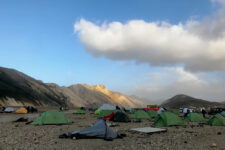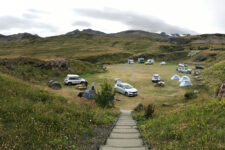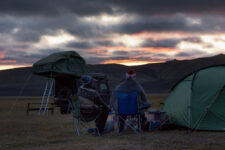Iceland has its public transit system, but it is not very developed. Many routes are great for cycling but the ubiquitous strong wind is a big negative factor. Vast majority of tourists choose driving as their way of moving about Iceland. But what kind of car should one rent?
Let’s discuss the pros and cons of all the kinds of vehicles that are available for tourists in Iceland.
Things to consider when choosing a car in Iceland
There are many factors that determine what type of car will best suit your needs in Iceland. Apart from the level of comfort you expect as well as the price you are willing to pay, you need to take into account the kind of trip you are going to have and the time of year you choose to go.
Some of the most important questions to consider are whether you’ll need 4×4 drive and where you’ll sleep. oraz jaki standard noclegów akceptujesz. And of course – the level of costs you accept.
How useful is a 4×4 in Iceland
In the summer (usually mid-June to mid-September) one can visit the interior of Iceland. It is soooo worth doing it because this is where many of the country’s top and most beautiful attractions are (see here: Top 10 of the Icelandic Interior ). If you go in the summer, it really makes sense to rent a 4×4 vehicle and see at least some of these places.
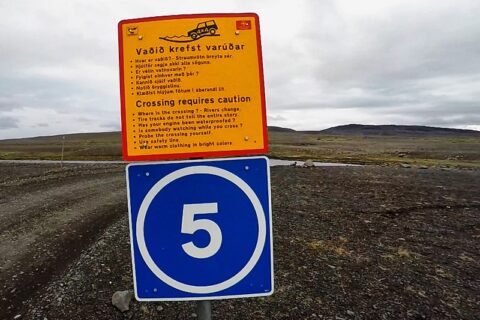
A ford crossing sigh.
Having said that, if you want to have nearly 100% certainty that you’ll get to all the attractions of the Icelandic interior, you may want to rent a proper off-road car. Toyota Land Cruiser and Mitsubishi Pajero are your classics, but obviously they are much more expensive to rent than Dacia Duster.
When you visit the interior it is very important to be aware whether the car rental company allows for a specific car model to drive on mountain roads (marked F) and whether it allows you to cross fords. Typical off-road cars are nearly always allowed (but even for them some roads are not covered by insurance). As for passenger cars with 4-wheel drive, different car rental companies may have different regulations…
A 4×4 car can be also useful outside of the summer months. Some interesting places that are not in the interior or on mountain roads may require driving on a steep gravel road that can be difficult for a regular car. From late fall till early spring you can expect snowfall everywhere. Having a 4×4 car makes driving in both these situations so much easier.
Sleeping in a tent
Everything (apart from breathtaking views!) is eye-wateringly expensive in Iceland. And sleeping in a tent can help you significantly lower your costs. At the same time – just like sleeping in a campervan – it gives you all the flexibility in planning and changing your route depending on the weather or the attitudes of your fellow travelers.
Unlike in many other countries, in Iceland you don’t need to book your place at a campsite of you are using a tent or campervan. All other types of accommodation are not only more expensive but also get sold out pretty quickly and you have to book more than 6 months ahead. What’s worse, you can hardly change or modify such reservations. Staying in a hotel, B&B or hostel may be more comfortable than a tent or campervan, but it makes your itinerary much more “rigid.” Whereas sleeping in a tent or campervan you can be spontaneous about what to do next. You can easily change your plan as you go.
Formally wild camping is allowed in Iceland. However, there is so many conditions and limits to it, that in practice it is only for the backpakers in wild interior.
- Firstly, it is only allowed in a ground tent. RV’s, campervans and roof-top tents are not allowed. You have to find a designated camping site to spend a night in those.
- Then it is forbidden in places with local bans (which applies to most tourist attractions).
- You can’t wild camp on private property without the owner’s consent. And Iceland’s land is mostly privately owned.
- Wild camping is also not allowed in National Parks and Nature Reserves (again: that’s all the popular tourist areas).
So in practical terms, wild camping is not a thing in Iceland. You can do that (usually) when hiking or going cross-country on a bike, but if a car is your means of transportation, you need to find a camping ground for the night.

Some campsites feel like wild camping anyway (Landmannahellir)

Evening at a campsite in JULY – Landmannahellir.
If
you visit Iceland with children, I am strongly warning you against a tent. Icelandic campsites are rather minimalistic, the wind is really strong and it is never really warm, even in the summer (especially at night!). The right campervan or a hostel is going to be work much better for you. Unless your kids are seasoned campers and cold-loving: in this case camping in a tent in Iceland can be an adventure they’ll cherish forever 🙂
In winter I suggest that everyone should opt for indoor accommodation – hotels, B&Bs or hostels. Even campervans, despite their heating systems, will not keep you warm enough. Plus, renting a campervan in winter requires additional responsibilities from you as a user. many of them may even not be available until May. And because all the roads are often covered in snow, having 4-wheel drive becomes essential.
Costs – rental, insurance, consumption
While different solutions have different important benefits, the more comfortable and multifunctional the vehicle is, the more expensive it will be to rent.
The price comprises the rental fee, insurance (it will usually cost you more for more expensive vehicles) and the gas you use. Moreover, the type of car you choose determines your accommodation type, which has a huge impact on the total cost of your trip.
T
he choice of models, versions, options, insurance policies and all kinds of additional fees (or lack thereof) is huge. Below we have described only a selection of the most typical or representative examples of rentals for 2022 rok, and we collected the data well in advance, in 2021.
It is fairly possible that you will find a better deal than what we have presented or that you can’t find such good deals because you are too late. These tables are here to give you an overview of what you can expect and how different car rental offers are structured.
| Car rental costs (14 days, June 2023) |
|
Kia Rio
(2 pax)
+ own tent |
Dacia Duster
(4 pax)
+ hostels |
campervan
(4 pax)
+ campsites |
motorhome
(6 pax)
+ campsites |
| car rental |
88,000 ISK
($630) |
105,000 ISK
($750) |
515,000 ISK
($3,680) |
680,000 ISK
($4,860) |
| insurance |
no additional insurance 1) |
25,000 ISK
($180) 2) |
65,000 ISK
($465) 2) |
25,000 ISK
($180) 3) |
gas
(2000 km / 1250 mi) |
45,000 ISK
($320) |
45,000 ISK
($320) |
50,000 ISK
($360) |
95,000 ISK
($680) |
Total
(car) |
133,000 ISK
($950) |
175,000 ISK
($1,250) |
630,000 ISK
($4,505) |
800,000 ISK
($5,720) |
| night stays 4) |
50,000 ISK
($360) |
320,000 ISK
($2,285) |
50,000 ISK
($360) |
90,000 ISK
($645) 5) |
Total
(car + accommodation) |
183,000 ISK
($1,310) |
495,000 ISK
($3,535) |
680,000 ISK
($4,865) |
890,000 ISK
($6,365) |
| Total per person |
91,500 ISK
($655) |
123,750 ISK
($885) |
170,000 ISK
($1,220) |
148,300 ISK
($1,060) |
Examples of prices for June 2023, booked 6 months ahead.
caveats
- Iceland can be really dangerous in a number of ways. Rumbomundo.com does not support skipping additional insurance; read more here Car insurance in Iceland;
- the price presented here is for a full insurance with covered deductible; learn more from a separate article about insurance;
- motorhomes are always offered with full or near-full insurance anyway, so taking out additional package is quite inexpensive;
- hostel prices based on shared dormitories; prices in a 4-person room can be similar;
- fees for hooking up to electricity not included, in practice it makes sense to pay to hook up to electricity at least every 2-3 days when you use a motorhome;
So, as the table presents, obviously the cheapest solution is to rent a regular, inexpensive car without an additional insurance package and sleep in your own tent. If you get a slightly bigger car, but go in a team of 4, you can keep the cost below $500 per person, which in Icelandic reality (in June) is a fantastic result for a 14-day trip. We still recommend taking full insurance coverage, but it’s a personal choice.
We outline more solutions and options below. But it must be stressed right away that your per-person costs will be higher with just 2 people traveling, going in May or earlier will be cheaper, while in July and August – more expensive (see below for comparisons of car rental prices in different seasons).
While the difference between April and June is considerable, renting a car in July can get even twice as expensive than in June and nearly three time more expensive than in April. If you have a knack for bargaining, your best chance to get additional deals and discounts and ultimately lower your trip costs are out of season. During the summer car rental companies won’t even start a conversation about discounts… By the way: car rental prices in winter are similar to those in spring (April). There is not much difference here because April is considered as much low season as February…
Therefore, WHEN you go has a huge impact on how much this trip will cost you. Additionally, the prices can change (as in go up), if you book on short notice.
Renting a passenger car in Iceland
Renting a 2×4/2WD passenger car
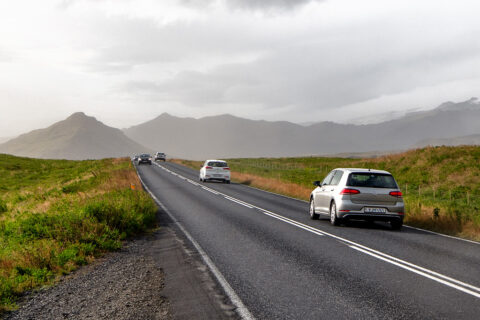
Many tourists go for regular passenger cars.
The downside of these 2-wheel drive cars is that not only will they not take you into the interior, but also some of the places near Route 1 will be off limits or will require a longer trek. These places include Dyrholaey, Haifoss, Raudisandur and Latrabjarg the two latter ones are in Westfjords). A trip without these attractions can still be great, however, not having w 4×4 may limit your freedom to a degree.
Although in the summer virtually any car can drive through the interior via road F35, if you rent a car without 4×4 drive probably the rules of the rental company or car insurance will prohibit you from doing that.
| The cost of renting a 2WD car (14 days) |
|
Toyota Aygo
(2 pax) |
Kia Ceed kombi
(4 pax) |
Renault Trafic
(8 pax) |
| April |
50,000 ISK
($360) |
80,000 ISK
($570) |
190,000 ISK
($1,360) |
| June |
70,000 ISK
($500) |
110,000 ISK
($790) |
250,000 ISK
($1,790) |
| July |
125,000 ISK
($900) |
200,000 ISK
($1,430) |
450,000 ISK
($3,220) |
As you can see the difference between cars are more or less aligned with their size. The cost per person is similar. But the price differences between seasons are massive.
Remember that if you are going in a group of 4, it makes good sense to rent a wagon, especially when you are planning to stay at campsites and you carry your own tents, burners, food supplies, etc.
The final price is also determined by insurance – the one included in the price and any additional packages. You may want to decide how well you want to be insured even before looking at car rental companies (see here: Car insurance in Iceland).
Renting a 4×4 passenger car
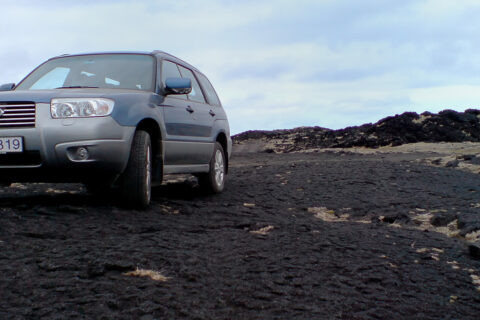
Skardsvik (Snaefellsnes)
Renting a 4×4 car is a bit more pricey than a 4×2. Also, your fuel consumption will be a bit higher. But these are not big differences and you can really use an all-wheel drive in Iceland.
A 4×4 vehicle gives you an advantage of freedom when driving around Iceland. The truth is that for many tourist attractions the so-called last mile is on a gravel road that is often in bad condition and even if it is rarely very steep, it is often steep enough to make you uncomfortable without 4-wheel drive. There are many such places; the most interesting ones include the above-mentioned waterfall Haifoss, Latrabjarg cliffs and Raudisandur beach (Fiordy Zachodnie), as well as this canyon Fjadrargljufur, this pool Seljavallalaug, the cave called Surtshellir, the waterfall Aldeyjarfoss, the lava field Berserkjahraun, the glacier Svínafellsjökull and the campsite Thakgil. With good weather and a skilled driver, you will get there. But driving a 4×4, you’ll feel more confident, reassured and comfortable.
The top parking area in Dyrholaey simply bans all cars without 4-wheel drive (which makes sense, so please don’t ignore it: The road gets very steep). And when you are in eastern Iceland, having a 4×4 car will allow you to take a picturesque and very steep – gradient of 17% (sic!) – shortcut between Hofn and Egilsstadir on road 939 (officially it is not marked as F, but in fact it is more of a mountain road than many other F-marked ones).
Bear in mind that some campsites in Iceland are just vast grasslands that can be really soggy after rainfall. So in a 4×2 car you have to be very careful as not to get stuck. In a 4×4 vehicle, you don’t need to worry about such things at all.
Moving on, as long as the car rental company agrees, a 4-wheel drive car drives easily on a 4-wheel drive car drives easily on F35 and you can see such cars on road F26, too. A 2-wheel drive car can surely take you up to Landmannalaugar from the north (but leave the car in a parking lot before the last ford) as well as to the charming Hveradalir in Kerligarfjoll and the very photogenic Studlagil canyon. For these tourist attractions you need to check with the car rental company for approval, but anyway, without 4-wheel drive they are off limits.
A brief summary: A 4-wheel drive vehicle is a big plus on your trip to Iceland. If you are planning to only follow the main tourist attractions along Route 1 (Top attractions along Route 1 (Top10 + 10 bonuses)), you will find 4×4 useful but not strictly a must-have. However, if you want to get into the interior (Top places of the interior of Iceland [Top10]), there is virtually no way you can do it without a 4×4 car.
| The cost of renting a 4×4 car (14 days) |
|
Dacia Duster 4×4 |
Subaru Forester 4×4 |
Toyota RAV4 4×4 |
Mercedes Vito
4×4 (8 pax) |
| April |
80,000 ISK
($570) |
110,000 ISK
($785) |
140,000 ISK
($1,000) |
230,000 ISK
($1,645) |
| June |
90,000 ISK
($645) |
120,000 ISK
($860) |
170,000 ISK
($1,215) |
230,000 ISK
($1,645) |
| July |
200,000 ISK
($1,430) |
225,000 ISK
($1,610) |
300,000 ISK
($2,145) |
600,000 ISK
($4,285) |
The prices of different 4×4 campervans are presented further down.
Price differences between different 5-seaters with 4×4 drive can even exceed 50%, but still the 9-seater Vito is clearly in another category. Dacia Duster is definitely the cheapest choice in this “class” and it surely is the smallest and has the least off-road capabilities. Meanwhile Toyota RAV4 offers more leg and baggage room. Plus it gives you more confidence driving in off-road terrain (for instance, in normal conditions you will have no problems whatsoever reaching this Landmannalaugar campsite or Basar Hut). The significantly higher price can be a problem but a RAV4 without additional insurance can be cheaper than a Dacia Duster insured to the teeth. This goes to show that insurance has a huge impact on your final rental price. (Find out all you need to know about insurance from this article: Car insurance in Iceland).
Unlike cars with regular 4×2 drive, this category has relatively small differences in rental prices between low season (April) and early high season (early June). It is only in the summer that prices soar considerably. This is because these vehicles become useful on mountain roads, which open only in the summer (usually mid-June). At the same time, a car like Subaru Forester costs only about 10% more than Kia Ceed wagon described earlier on. Because 4×4 cars give you a real advantage in Iceland all year round, you may want to consider the Forester or something similar.
A minivan with 4-wheel drive (like the Vito above) is a rather rare model, so its rental price may vary significantly depending on your preferred dates and when exactly you are checking the price.
All the vehicles whose prices we present above are authorized to drive on mountain roads (marked F), but individual rental companies may impose some restrictions. For instance, roads F88, F246 or even F210 may be exempt from insurance. Sometimes you encounter clauses allowing a vehicle on F roads but without crossing fords/streams, making many roads off limits. It happens that a rental company allows you to go on mountain roads only when you buy additional/full insurance. There are no general or clear rules here and when you find a car that you like, you need to confirm all the details with the rental company.
Renting an true off-road car
Iceland as seen from the asphalt Ring Road is surely beautiful. But the interior is a whole different experience altogether. You won’t see many people there and the views are breathtaking. It is the closest and most accessible place (in Europe at least) where you can encounter such a wide variety of astonishing volcanic and glacial landscapes. But to see all this, you need a 4×4 vehicle.
R
emember: off-road driving is prohibited in Iceland. A lot of mountain roads (marked F, like F910) still do give this off-road feel – you have to drive up gravel roads of 17% inclination or ford a lot of mountain streams on those ‘roads’. So off-road driving is prohibited, but an off-road car is very handy.
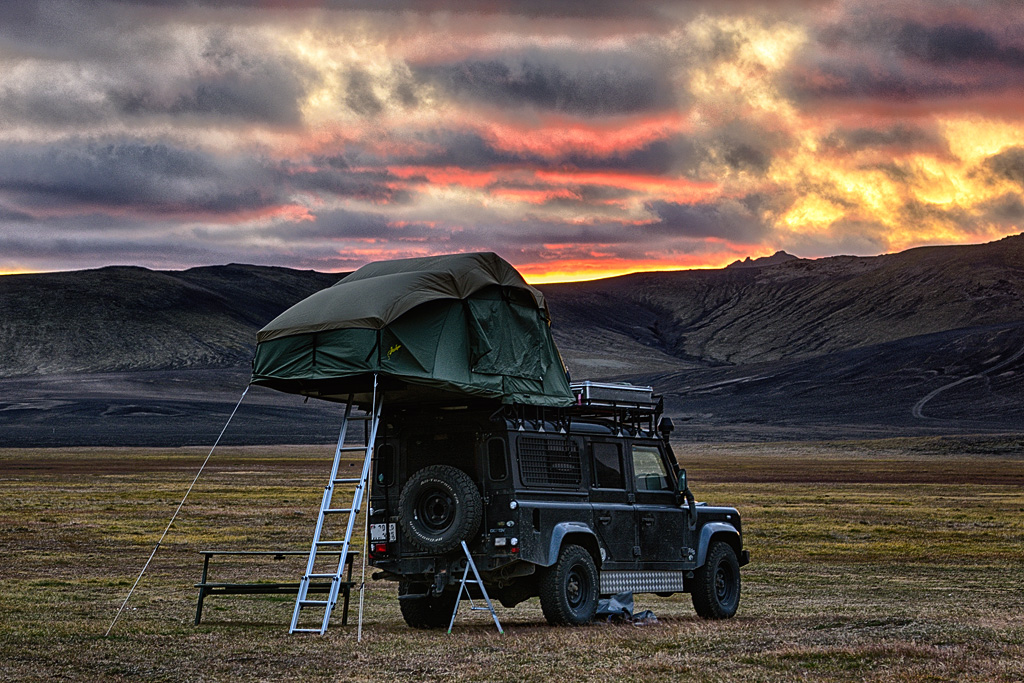
campsites in the interior are often quite deserted.
As we mentioned above, a regular passenger car with 4-wheel drive also is well able to take you to plenty of great places in the interior of Iceland. But very often car rental companies don’t allow you to cross streams, meaning that many roads in the interior are unavailable for you. And even if the rental company agrees, reaching such places as Basar Hut (Thorsmork), Laki, Landmannalaugar, Askja or even Hveradalir (Kerligarfjoll) in a car without a high suspension will be really difficult, if not reckless (although I admit that Dacia Dusters have been known to reach all these places).
As much as the so-called vehicle snorkel, meaning the air inlet reaching above the roof, is a bit much for a regular tourist in Iceland, a high suspension, proper reductor, mechanical differential lock and big off-road tyres really make a difference on steep gravel roads and while crossing streams, which are numerous in the interior.
R
emember that it is the driver that makes the car go. If you don’t have experience in off-road driving, even when you plan to rent a Toyota Land Cruiser, do take an off-road course before you enter Thorsmork or road F88. Bear in mind that even “full” insurance usually does not cover damage caused by drowning the car and some roads that are not covered either.
Off-road vehicles tend to be bigger and have more room. It is easier to fit your luggage and passengers in the backseat will be much more comfortable. If you are going for 2 weeks or more it really matters. These cars are more expensive to rent; they sure consume more fuel. But for those who don’t just want to go around Iceland on the Ring Road but also explore its interior, such a car is a great idea.
As we mentioned in the beginning, the big factors that will determine the cost of your trip are accommodation and car insurance packages. For more clarity, cars with room to sleep in (be it a rooftop tent or berths inside) are described together with campervans, further down in the article.
| Costs of renting larger off-road cars (14 days) |
|
Kia Sorento 4×4 |
Toyota Land Cruiser 4×4 |
| April |
170,000 ISK
($1,220) |
280,000 ISK
($2,000) |
| June |
215,000 ISK
($1,540) |
315,000 ISK
($2,250) |
| July |
375,000 ISK
($2,680) |
500,000 ISK
($3,570) |
Prices of 4×4 campervans are presented further down.
Kia Sorento is a big car with good off-road features. It is longer, with a higher suspension and larger wheels than the popular Dacia Duster. It gives you a smoother ride on tarmac, but essentially – more flexibility and safety when crossing fords and creeks. However, only in a Land Cruiser (or Mitsubishi Pajero and the like) you can have the full confidence that – as long as nothing unusual happens (in Iceland these unusual things include volcanic eruptions or glacial floods) – you’ll get everywhere with no problems. In such a vehicle you need to stop and have a good think only in rare occasions, like crossing Krossa and fords along F88 (seriously, if you don’t have experience driving off-road in deep water, just skip these two places).
Should I rent a campervan in Iceland?
You will find plenty of various campervans in Iceland. As you review all of them, be aware of fundamental differences between them. Heated sleeping space, kitchen with a stove with a big burner, sink and refrigerator as well as a basic but functional bathroom are the features that distinguish one type of campervan from another. The largest ones also have some living-room-type of space while the smaller ones allow you to sleep inside but not much more, so cooking or evening chats have to happen outside or in a campsite’s kitchen area.
C
ampervans are great in Iceland in late spring. In May and June days are long, campsites are open, roads are clear and it is not so freezing at night. And in this period the prices of campervans are still reasonable. A trip to Iceland in June in a campervan is a relatively comfortable and inexpensive idea.
The pros and cons of each campervan type are discussed further down. Here we just put them into categories for clarity:
- Motorhomes
are the largest, with a kitchen, bathroom, warm water, fridge, many lights and electrical sockets, big beds and plenty of space, both for passengers and their luggage. The most popular ones have 6 berths but you can find both smaller and bigger ones. if someone says “campervan”, usually they mean a motorhome – a little house on wheels;
- 4×4 campervans
are usually trucks (such as Dodge Ram) with a small trailer mounted on the back. They are much smaller than motorhomes and have no bathroom, but still they are more spacious than most campervans, with a kitchenette and a fridge. You can stand up straight inside. These are great for the interior of Iceland;
- Campervans
are usually modified minivans but you can find off-road cars made into campervans. They have sleeping room (so you can stay warm), they offer good protection from wind and (usually) heating that stay on while parking so you can keep warm during cold nights; usually they come with a small fridge; there is no bathroom and the kitchenette is no more than one big (or just regular size) burner that is not very convenient to use, especially in the smallest models;
- Rooftop tent
in Iceland off-road cars with rooftop tents are classified as campervans just because they come with full camping gear: a camping stove, plates, cutlery, folding chairs, etc. But they rarely have a fridge. Their advantage over your own tent is in that the rooftop tent is easy and quick to set up. The fact that you just have one tent is a disadvantage – such cars are just for 2 people;
Below we are describing them all in detail, in reverse order: from the simple cars with rooftop tents to fully equipped motorhomes.
Renting a car with a rooftop tent
The main reason why regular cars with rooftop tents are considered campervans in Iceland is that they come with basic camping equipment. If you plan on sleeping in your own tent on the ground, you’ll have to bring it with you, plus the stove, plates, cutlery and everything else you need at campsites. However, a car with a rooftop tent already has all this included in price.

Typical Dacia Duster with a rooftop tent.
Compared to small, 2-person campervans you get quite a lot of baggage room so there’s no need to rearrange all the bags every night before going to sleep. It is really practical and convenient. But having no heating in the sleeping area is a high price to pay for this convenience.
Car rental companies will offer you this car in all seasons, but Icelandic nights in an unheated tent can get cold even in the summer. Therefore, most tourists consider this option attractive only throughout the summer months – from June till August. Staying at campsites is a good way to save money and you are getting maximum flexibility: You can change your plan as you go.
| The cost of renting a car with a rooftop tent (14 days) |
|
Dacia Duster |
Suzuki Jimny |
| April |
200,000 ISK
($1,430) |
330,000 ISK
($2,360) |
| June |
225,000 ISK
($1,610) |
360,000 ISK
($2,570) |
| July |
265,000 ISK
($1,900) |
650,000 ISK
($4,650) |
As you can see Suzuki Jimny is much more expensive even though it is the smallest. At the same time, its price increases the most during the summer. Dacia is certainly a much better choice in this category. Nevertheless, it needs to be said that with 4 or 5 people coming to the trip, renting a proper campervan may not be more expensive and it surely will give you more comfort (plus, it is usually much more merry in a group of 5 🙂 ).
Renting a campervan
Like the name suggests, campervans are usually modified vans. In the back part you have sleeping space that can be arranged like a lounge/kitchen during the day.

Popular sizes of campervans
Such vehicles have the same drivability as the “basic” model they were adapted from while sleeping and cooking conditions are rough but sufficient.
In these campervans cooking is almost always enabled by a small camping stove with gas cartridges (round and oblong, they look a bit like cans of air freshener). The stove usually has one burner but sometimes you get (or can rent) 2 stoves. So your cooking conditions are only marginally better than when you are at a campsite with your own tent. Cooking inside makes the interior steamy immediately and opening the door means you’re letting the cold air in.
S
maller campervans usually DO NOT have a fridge. And while bigger ones do, it only works when you are driving and there is no freezer. Take all this into account as you make your choice.
Additionally, a campervan has really little room in the back, so it is more a ten on wheels than a motorhome. It would be convenient to put up your table and chairs outside to cook and eat, but the strong and ubiquitous Icelandic wind makes it, mildly speaking, challenging.
Anyway, since you stay at campsites, you can (usually) cook in the common kitchen/canteen area, so the problem of confined space disappears.
T
he bedroom section of a campervan offers little space but enough to get a good night’s sleep. Obviously, it can be compared to a tent rather than a hostel bed. However, unlike a tent the car has hard walls protecting you from the wind and heating, both of which make a huge difference even in the summer. In practical terms this solution is very functional also in spring and autumn, when iceland is less crowded with tourists and all the prices are considerably lower..
Naturally, a car like this has no bathroom facilities, let alone a shower. But these amenities are available at every campsite, however, they are not always included in the price (but they are never expensive).
Renting a campervan will always be prices than a 4×4 car, but having a place to sleep you don’t spend on accommodation and you don’t need to worry about bookings. The surface beneath you is always flat and even and you are well protected against the wind and cold. This solution is certainly more comfortable than a Dacia Duster and a tent on the ground.
| Costs of renting a campervan (14 days) |
|
| Citroen Berlingo (2 pax) |
Dacia Duster 4×4 (2 pax) |
Mitsubishi Pajero 4×4 (2 pax) |
Renault Master (5 pax, fridge, sink) |
| April |
1450 EUR
($1,555) |
2300 EUR
($2,470) |
2800 EUR
($3,000) |
2650 EUR
($2,845) |
| June |
1450 EUR
($1,555) |
2750 EUR
($2,950) |
3200 EUR
($3,440) |
2800 EUR
($3,000) |
| July |
1700 EUR
($1,825) |
3650 EUR
($3,920) |
4750 EUR
($5,100) |
4500 EUR
($4,830) |
As you can see in the table above, the smallest campervan is not only much cheaper than the rest but its price does not pick up as much in the summer. The prices of the remaining 3 models are rather similar, so renting a Master is the cheapest per person. Mind you, this car has a front-wheel drive, so comparing it to Pajero or Dustera is a bit unfair.
H
iring a Dacia Duster campervan (with sleeping space inside) is significantly more expensive than the same car with a rooftop tent. The tent is colder but the difference in price can buy you two excellent sleeping bags…
4×4 campervans – Iceland’s specialty
This solution deserves special attention: It is a hybrid created by mounting a small camping trailer on top of a big off-road pick-up truck. It is hard to describe it better, just look at the image below.

A 4×4 campervan in Thorsmork
Such a campervan is a compromise between an off-road car and a motorhome. You can encounter it in other parts of the world, but it is here in Iceland that it shows undisputable benefits.
First of all, this type of campervan, like a motorhome, has a kitchenette: Smaller and more modest than one in a motorhome, but it is there. We get a decent size sink, a fridge with a freezer than works non-stop, large, convenient cabinets. The fridge is a nice size, the water and the whole interior is heated with a gas tank, which makes your journey comfortable, even if you can’t hook up to electricity at a campsite. However, just like in the other kind of campervan, there is no toilet or shower here.
The “living” space is the size of the largest campervans (for instance, you can easily stand up straight), but it is still cramped compared to motorhome. The cab is an American 6-person standard setup, so there’s enough space.
Unlike in the other types of campervans, here you can’t go from the cab to the living space without leaving the car. Each time you have to get out and go round the back. It is no big deal, but still a bit of a nuisance.
Mountain roads are where this 4×4 campervan get a chance to really shine. Dodge Ram 1500 (or similar) trucks that these campervans are based on offer you 300 horsepower, all-wheel drive, a differential lock and a reductor. The big, tall wheels as well as a high suspension are part of the package as well. It is a genuine off-road vehicle.
These campervans may look weird but they do their job in rough terrain. They will take you everywhere in the interior no problem (with the only exception of Krossa, but the tough drivers ones will not get scared) and you get to cook and sleep in relative comfort – less than a motorhome or a hostel but incomparably more than a typical campervan or a tent. Moreover, it is a 4-seater so it can be cheaper per person than campervans based on typical off-road cars like Toyota Land Cruiser.
It
is not exactly true that a 4×4 campervan is a compromise between an off-road car and a motorhome: It is the best of both.
You need to be aware of a certain a downside – high fuel consumption. Large front and side surface causes huge resistance. Additionally, the car is heavy and usually has an American automatic transmission, meaning that the consumption of 20 liters per 100 km while driving off-road is nothing unusual at all… High side walls make the vehicle sensitive to gusts of wind. Fortunately, the bulk of the car makes it stable despite the wind, unlike a motorhome, and as a driver you just feel the wind through the steering wheel.
To recap: It is a really interesting solution for 4 people. If you want to see the interior and are ready to pay a bit more for extra comfort (compared to a regular campervan or a tant) do consider a 4×4 campervan.
| 4×4 campervan rental costs (14 days) |
|
Toyota HiLux (3 pax) |
Dodge RAM (4 pax) |
| May |
2800 EUR
($3,000) |
4150 EUR
($4,450) |
| Jue |
3300 EUR
($3,540) |
4250 EUR
($4,560) |
| July |
4950 EUR
($5,310) |
6850 EUR
($7,350) |
4×4 campervans are only useful from June to August.
As you can see from the table 4×4 campervans are rather expensive to rent. But when you calculate the cost per person (assuming full “occupancy”), they are cheaper than the Pajero or Duster we mentioned before. Still, compared to a Dacia Duster with a rooftop tent a 4×4 campervan may be even twice as expensive per person. They certainly are more comfortable to drive, cook and sleep in, but the price you pay for the convenience is pretty high. As we illustrate in another table below, for the price of a Dodge Ram one can rent a luxury 6-person 6-osobowy motorhome. You will not be able to drive the latter on gravel but if you stick to asphalt, a motorhome is even more smooth and comfortable.
Renting Motorhomes (RVs) in Iceland
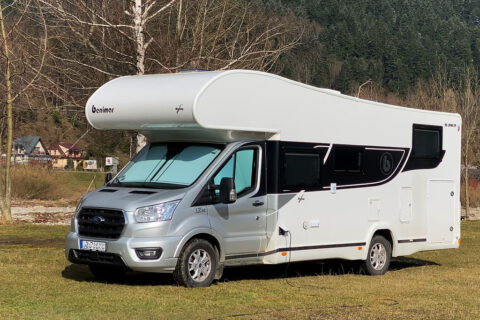
A modern motorhome
The basic characteristic of a motorhome is that you have not only a rather spacious and well-equipped kitchen with a fridge, sink, oven and a stove with a few burners but also a shower and toilet. Usually motorhomes come with an awning you can open, however, its usefulness in Iceland is nonexistent due to nearly constant strong wind and precious little sunshine barely showing over the horizon.
The comfort you experience driving in a motorhome is absolutely incomparable to anything else we have described here. Not just because of the nice and convenient kitchen and a small but functional bathroom but also because these vehicles come with big tables to eat or play cards at; they have many well-lit corners to sit and read; a million compartments where you can store your things; plenty of 220V and USB sockets, plus (usually) a nice and broad selection of camping furniture.
There really are homes on wheels, giving you the best combination of comfort and flexibility because you can stay at campsites, which do not require booking in advance.
There is a “but” though: Every 2-3 days it is good to find a place to hook up to electricity. In spring it is not a problem at all, but in the summer you would have to find a less crowded campsite or make a booking at least a day before. Campsites will always fit you in, but your space may not necessarily come with electricity. Of course a motorhome works just fine without it, but all your 220 V sockets won’t, so you won’t be able to charge all your large devices, ones that can’t charge via USB or the auxiliary/cigarette lighter socket.
Remember that the maximum number of people allowed means that some of them (usually 2) will have to sleep in the dining area, on berths that unfold when you fold the table and couch. You have to set it up and fold back every night and morning, plus the people sleeping there have to be the last ones to go to sleep and the first ones to get up. It is not too much of a problem, yet it can make things a bit less comfortable. On the other hand, renting a 6-person motorhome for 4 people – and having no one sleep in the dining area – is simply quite expensive.
Renting a campervan for a maximum number of people you need to bear in mind that all your “consumables”, like water and toilet cassette/tank, will run out/fill up pretty quickly. It is not a big deal since you stay at campsites every night anyway so you just plan to fill up the water tank and empty the toilet. These things are impossible to miss. You also need to remember to fill your gas tank (or rather replace the gas tanks). Not every fuel station offer this service so if the first tank has run out and you are on your second tank – replace the first one as soon as you get the chance. Without gas your stove, fridge and heating won’t work, so this is a serious matter.
When it comes to driving a modern motorhome, it is nice and easy. But you need to be aware of the sheer size of your vehicle. While maneuvering in parking lots and campsites, watch out for the rear (the rear wheels off-track, meaning they sweep a wider path than the front ones) and the roof – you don’t want to snag something…
Video: Maneuvering a motorhome.
Naturally, a motorhome’s fuel consumption is quite high and it is sensitive to gusts of wind. Most car rental companies do not allow clients (which is reasonable) to go off asphalt roads. This makes the interior of Iceland off limits for motorhomes, but it is perfect for a journey along Route 1 (and its branches).
A motorhome is a very smart solution that combines comfort with independence and flexibility throughout your trip.
| The cost of renting a motorhome (14 days) |
|
Motorhome – 4 pax |
Motorhome – 6 pax
Economy |
Motorhome – 6 pax
Luxury |
| April |
3000 EUR
($3,220) |
3200 EUR
($3,430) |
3900 EUR
($4,185) |
| June |
4180 EUR
($4,485) |
4500 EUR
($4,830) |
4700 EUR
($5,045) |
| July |
5950 EUR
($6,385) |
6250 EUR
($6,710) |
6550 EUR
($7,030) |
As you can see looking at the table above, motorhomes do not come cheap. Interestingly, the price difference between the smaller, cheaper one and the largest, most pricey one is rather insignificant. In the summer it is no more than 10%. Additionally, when you calculate the cost per person, the smallest motorhome turns out the most expensive.
And although these cost are undoubtedly high, when you look at them per person even the big and luxury model is competitive compared to the other options we described above. Clearly even when you calculate the price per person, a motorhome costs twice as much as a Dacia Duster with a rooftop tent but it is incomparably more comfortable to travel and stay in.
Recommended car rental companies in Iceland
When you have chosen the type of car that best suits you, you still need to actually rent it. There are plenty of rental companies in Iceland and you rarely encounter any negative reviews about any of them. The staff are nice, they often speak Polish and they always speak English. In most cases you collect and return your vehicle with no problems and everything goes smoothly. You can pay with card for everything and everyone will want to sell you additional insurance. Car rental companies usually specialize in either passenger cars, campervans or motorhomes.
You need to check prices as you go and it is always a good idea to ask for special deals and discounts: It often works when you give a good reason (for instance because you are an “early bird” or because you rent at the last minute or for a very long period or a very short one, etc.) You may want to be sure first whether you want full insurance or just partial coverage. Whether something is a good deal often depends on whether you compare variants with full insurance or not. The types and advantages of available insurance options are discussed in this article Car insurance in Iceland.
Recommended car rental companies – passenger cars
Renting a car in Iceland – like in many other parts of the world – is a process dominated by all kinds of comparison sites, integrators and middlemen. But even if you go through another company rather than rent directly from a car rental business, prices are the same (commissions are covered by car rental companies) and you get a much wider selection of what’s available. So I think that such sites are worth giving a try.
We recommend using the following short list:
- Discover Cars
This service offers a very wide selection of cars at different, but generally attractive, prices; it allows perhaps the easiest and fastest way to compare a multitude of offers, especially since of all the recommended portals it is here that we have the most types of filters at our disposal – so we can, for example. choose only offers without deposit or only those with winter tires; unfortunately, the options for selecting insurance are very limited here, but for that many offers allow free cancellation up to 2-3 days before the start of the rental, which is sometimes very useful;
example prices for 5 days in June 2023: Peugeot 108 (“or similar”): $450; Dacia Duster 4×4: $545;
- Reykjavik Cars
Contrary to what the name suggests, the company operates not only in Reykjavik; virtually every time we check it, this is the one that offers lowest rental prices for all types of cars, as it specializes in working with local rental companies.
The service is also well adapted to Icelandic conditions – it gives, for example, the possibility to filter offers according to whether the car is approved for F roads or not (and it’s not always the same whether it has 4×4 drive); the service also offers probably the widest options available on the market for personalizing insurance options (and this is important, because sometimes insurance costs second as much as the rental itself); unfortunately, the service has only an English-language version, but for that the staff responds to emails very, very quickly;
example prices for 5 days in June 2023: Toyota Aygo (cheapest): approx. $390 (ISK 54,830); Hyundai Tucson 4×4: approx. $610 (ISK 85,500);
- Rental Cars
The Rental Cars service is part of the Booking Group. com and offers the widest selection of cars, of all presented here; unfortunately, 24-hour car pick-up already at the airport, for example, is not always available, but sometimes you can find interesting bargains here;
example prices for 5 days in June 2023: VW Up! (cheapest available, but tiny): $498; Suzuki Jimny 4×4 (great off-road!): $865
Recommended car rental companies – campervans and RVs
When it comes to campervans, you can see in Iceland a rather clear division between rental companies that offer motorhomes and those that offer campervans and off-road campers. These are indeed different vehicles, with different equipment, requiring different service, and at the same time different customers who are interested in them. So the division between motorhomes and “the rest of the world” has a lot of justification.
When renting an RV, numerous details are very important. Does the camper have heating, what kind of stoves (how many?) will we get for the trip, does the refrigerator have a freezer and does it work all the time, what kind of tires are on the car, what kind of roads will we be allowed to drive on, etc. etc. etc… That’s why here the services with extensive features and descriptions of cars win.
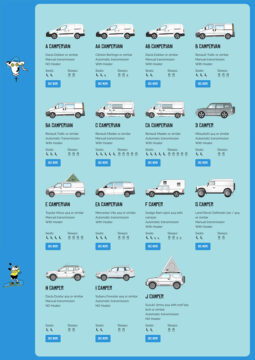
KuKu Campers’ wide range
A very good offer is also presented by CamperVan Iceland The choice of vehicles here is not the widest, but they have both campervans and motorhomes in one place for convenient comparison. Importantly, the company doesn’t force full insurance, so experienced drivers can rent a car much cheaper. On the other hand, there are quite a variety of extras and accessories as options.
Particularly noteworthy in the CamperVan Iceland offer are perhaps the 5-passenger 4×4 campervans approved for F roads. These are cars based on VW Crafter or Ford Transit bodies, so relatively spacious and comfortable, but not ‘full-blooded’ off-roaders. They have, however, been converted into 4WD campers and, importantly, approved by the rental company for use on mountain roads and streams (although the latter, as everywhere, at your own risk). If you’re lucky, you can rent them at a very competitive price. And at the same time, they can handle well all ‘non-extreme’ mountain roads in Iceland. However, when the water level is high, we recommend very far-reaching caution before driving such a car into a stream.
Regarding motorhomes, I think I recommend the world standard: the MotorHome Republic website. Very wide selection of motorhome campers (but also campervans) in different prices, sizes and variants. The vehicles are well described and presented, and the vast majority of options (add-ons and insurance) are fully self-selectable.
Other tips about driving in Iceland
The total cost of your rental car depends to a large degree on the scope and price of the insurance cover. There are a few types of insurance policies in Iceland that are not so common in other countries. Additionally, the whole structure of car insurance solutions sold to tourists is totally different from what you can buy elsewhere, for instance in Poland. Find out more about the structure, scopes of coverage and prices of car insurance in Iceland from this article: Car insurance in Iceland.
If you are planning to visit Iceland, you definitely should read up on road conditions and weather specific to this country as well as regulations and, just in case, fines for some traffic violations. You can find out about all this here: Road conditions, traffic regulations and fines in Iceland.
If you are wondering what route you should take and what kind of car would be best, read our description of major and most interesting roads in Iceland. Maybe you’ll want to take some of them. Here is all you need to know: Major roads in Iceland.
Go on and read the Top10 lists we have prepared to make it easier for you to select the most exciting places to see. Start withBest things to see in Iceland [Top 10].


